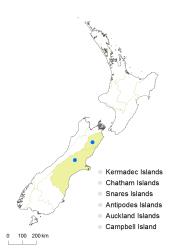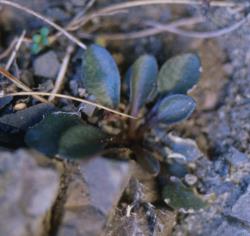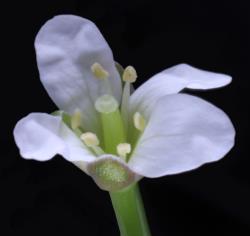Perennial herb, single rosette or with short lateral branches. Leaves up to 98 mm long, simple or occasionally pinnatifid; lamina 4.0–45.0 × 2.5–23.0 mm, grey-green, coriaceous, glabrous or occasionally with 1–3 marginal hairs; petiole up to 43 mm long. Terminal pinna 4.0–45.0 × 2.5–23.0 mm, simple, broadly elliptic to broadly elliptic-obovate, sometimes elliptic-rhomboid; margin entire to shallowly sinuate, sometimes with 2 prominent teeth, hydathodes ± indistinct; apex obtuse to subacute, with a distinct hydathode; base cuneate. Lateral pinnae 1–4, 2.0–5.0 × 1.5–3.5 mm, broadly elliptic; apex obtuse; base truncate; sessile. Cauline leaves similar to rosette leaves but smaller, narrower, base attenuate. Inflorescence racemose, with lateral racemes, terminal flowers in a cyme-like cluster, each raceme 3–22-flowered; peduncle up to 300 mm long, 0.4–1.9 mm diam. at base, ascending to erect, glabrous. Pedicels 20.0–60.0 mm long, 0.4–0.7 mm diam., glabrous. Sepals 2.9–3.0 × 1.2–1.6 mm, elliptic-oblong, saccate, green to red-brown, glabrous, margin white and membranous, apex obtuse, base truncate. Petals 4.5–5.2 × 1.9–2.5 mm, white, limb obovate; apex obtuse; base attenuate, tapering to a c. 1.0 mm long claw. Stamens 6; median filaments 4, 3.0–3.4 mm long; lateral filaments 2, 2.5–2.6 mm long; anthers 0.3–0.5 mm long, cream to pale yellow, when dehiscent held at a similar height to or slightly below the stigma. Ovary 3.2–3.4 mm long, 0.4–0.6 mm diam., ± terete, green, glabrous; ovules 56–62; style c. 0.2 mm long, ± terete; stigma 0.5–0.6 mm diam. Siliques 13.0–30.0 × 1.2–1.5 mm, glabrous, style 0.6–1.0 mm long; valves green to yellow-green at maturity and when dehiscent; replum 0.4–0.5 mm wide. Seeds 1.0–1.5 mm long, 0.65–1.0 mm wide, 0.3–0.4 mm thick, oblong, orbicular-oblong to broadly oblong, henna; wing absent.
Cardamine pachyphylla is distinguished from C. bilobata by its leaves having a longer and wider terminal leaflet, a smaller flower with petals 4.5–5.2 mm long, and a silique with a shorter style.
South Island: Marlborough, Canterbury.
Cardamine pachyphylla is known from greywacke mountains in eastern South Island, where it occurs in Torlesse Range (Canterbury) and Inland Kaikōura Range (Marlborough).
Cardamine pachyphylla occurs on shaded bluffs and rock outcrops, typically in lower-elevation alpine sites.
Cardamine pachyphylla is assessed as having a conservation status of Threatened, Nationally Critical A(1), with the qualifier Data Poor (de Lange et al. 2018). The qualifier Data Poor is applied because this species is known with certainty from few locations and additional information is required on the number and size of the populations.
Flowering November–March; Fruiting November–March.










